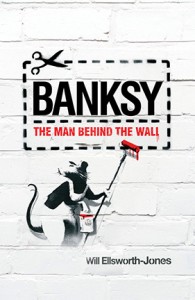Home »

Banksy’s place in graffiti art world explored
Book Review
By Derryll White
 Ellsworth-Jones, Will (2012). Banksy
Ellsworth-Jones, Will (2012). Banksy
I had never heard of Banksy before I picked up this book, but I have been fascinated with graffiti for a very long time.
I have spent hours trying to decipher the writing on train cars, walls, lampposts and a myriad of other media. I have photographed that art which I considered to be good or interesting. Art! What do I know, but I do know what I like and I love pieces that make me marvel, make me wonder just what is going on in that honest mind outside the law. For the mind is what informs the skill of the best graffiti artists, I think. They are, at best, significant social commentators, throwing our world (with a twist) back in our faces for processing.
The author goes a long way in pointing out that graffiti is a culture, is a way of giving voice to an alienated, unentitled collection of individuals. Like most artists the graffiti practitioners are on the margins of society, always contending with the illegal nature of their deviation. But it is clear here that the artist finds voice in the medium, and that the outside pressures combine to legitimize a sense of true culture within the practitioners.
There is as well a political context that Banksy addresses in talking about stencil work as opposed to bombing and tagging. While stating that all graffiti is low-level dissent, he points out that stencil work is razor-edged. “They’ve been used to start revolutions and stop wars. Even a picture of a rabbit playing the piano looks hard as a stencil.”
The author explores at some lengths the attitudes and processes underlying graffiti. What probably sets the art form apart from all other art is the vandal nature of it. To paint is to deface in the eyes of mainstream society. The pressures brought to bear on the artists by police, video surveillance and railway authorities – culminating in fines and jail time – excludes many potential artists. But this same dynamic gives a home to the anarchic souls who delight in living outside the law. What is also interesting, however, are the social mores and codes created within the tight graffiti community. They collectively do not have much tolerance for anyone breaking into the scene or breaking with the tight code of conduct.
The fact that Banksy, now an internationally-acclaimed artist, could so forcefully bring stenciling into the street culture of graffiti seems to pay tribute to his large sense of himself as a loner, and also to his strong personality. Will Ellsworth-Jones cites many instances of other graffiti artists who have large issues with both Banksy’s style and conduct.
This is a fascinating book. It explores in-depth how a street-smart artist employed talent, guts and marketing skills to rise to the top of the emerging street-based art world. In the process it sends up a lot of establishment views and attitudes, and offers a clear insight into a culture and devotion that many still consider to be populated by vandals and anarchists. Art, good art, was ever thus!
 – Derryll White once wrote books but now chooses to read and write about them. When not reading he writes history for the web at www.basininstitute.org.”
– Derryll White once wrote books but now chooses to read and write about them. When not reading he writes history for the web at www.basininstitute.org.”







